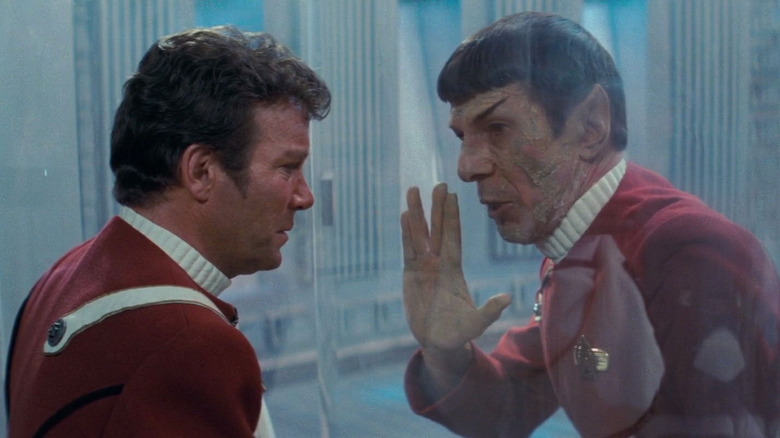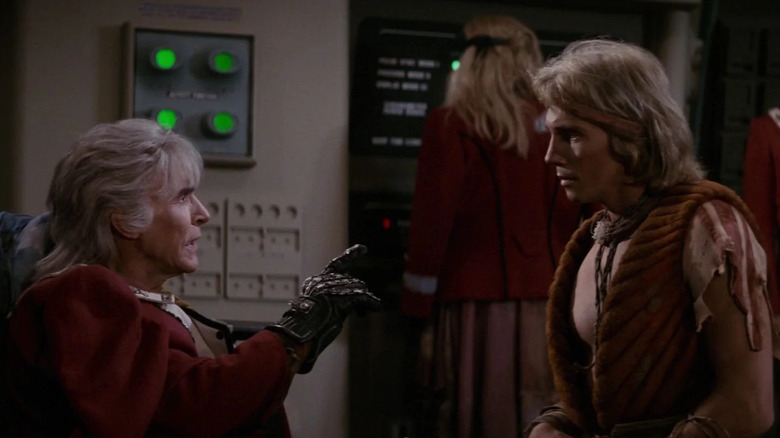Paramount
“Star Trek II: The Wrath of Khan” has carved a significant place for itself in the Star Trek franchise’s history. It is widely regarded as the finest movie in the series despite the challenges faced in its creation. Following the lukewarm reception of “Star Trek: The Motion Picture,” Gene Roddenberry, the franchise’s creator, was sidelined. This paved the way for a more intense and darker Star Trek narrative. “The Wrath of Khan” is a dramatic saga that tracks the journey of the U.S.S. Enterprise crew led by Admiral James T. Kirk (William Shatner) as they confront the genetically engineered villain Khan Noonien Singh (Ricardo Montalbán). Khan, a formidable antagonist from “Star Trek: The Original Series,” particularly the “Space Seed” episode, was reintroduced, upping the stakes. Khan posed a real threat by stealing the Genesis Device, a terraforming technology that could obliterate an entire world and transform it into a verdant paradise.
Khan seeks vengeance on Kirk for exiling him for 15 grueling years on a planet that eventually became uninhabitable. Despite his lethal intentions, Khan is somewhat a sympathetic villain because he aspires to serve his people and has endured immense hardship. However, the original plans for “The Wrath of Khan” painted his character in an even more tragic light, incorporating a twist involving his infant son.
The Tragic Turn of Events Involving Khan’s Infant Was Deemed Overly Sorrowful

Paramount
The initial screenplay of “Wrath of Khan” penned by Harve Bennett and Jack B. Sowards, which was later entirely revamped by director Nicholas Meyer, includes a scene where U.S.S. Reliant Captain Clark Terrell (Paul Winfield) and Pavel Chekov (Walter Koenig) — who begins the film as the Reliant’s first officer — encounter an infant while discovering the Botany Bay, Khan’s sleeper ship, on the planet Ceti Alpha. This child, supposedly Khan’s son, was intended to reappear at the film’s conclusion, crawling towards the Genesis Device on the Reliant’s teleporter pad, just before Khan triggers the device, annihilating them all. Despite Khan’s claim of wanting to build a new future for his people, he was prepared to sacrifice his own son to extract his ultimate revenge on Kirk. This ending, though profoundly bleak, aligns well with the themes and ideas Meyer was exploring. However, it might have been excessively dark, especially with Spock (Leonard Nimoy) sacrificing himself to save the Enterprise.
There’s evidence that the scene was filmed, as a photo of Meyer directing the scene with the baby on the telepad appeared in a 1982 issue of “StarBlazer” magazine, but unfortunately not much else has surfaced. Meyer, known for his tough demeanor, didn’t shed a tear while filming Spock’s poignant death scene, indicating that the decision to remove the scenes featuring Khan’s baby was likely not his. While the removal of these scenes didn’t drastically alter the movie, they would have added another layer of complexity to Khan’s character.
Roddenberry Believed Khan Was Shortchanged

Paramount
Even though it’s doubtful that Roddenberry would have wanted to include the subplot involving Khan’s son, considering it’s too grim for his optimistic worldview, he believed that Montalbán deserved a more substantial role in the script. He was highly critical of the film but acknowledged the actor for rescuing it, transforming some of the cheesier lines into something more dramatic.
While “The Wrath of Khan” wasn’t universally loved and faced harsh criticism initially, it has since become a fan favorite. Much of its success can be attributed to Meyer’s direction and the high-octane entertainment it provided in comparison to “Star Trek: The Motion Picture.” Khan also plays a significant role as a remarkable villain. Had the scenes involving his son been retained, his character might have been more nuanced and compelling. However, it’s understandable why the studio decided against a more depressing ending that could potentially alienate audiences.
Credit: www.slashfilm.com


